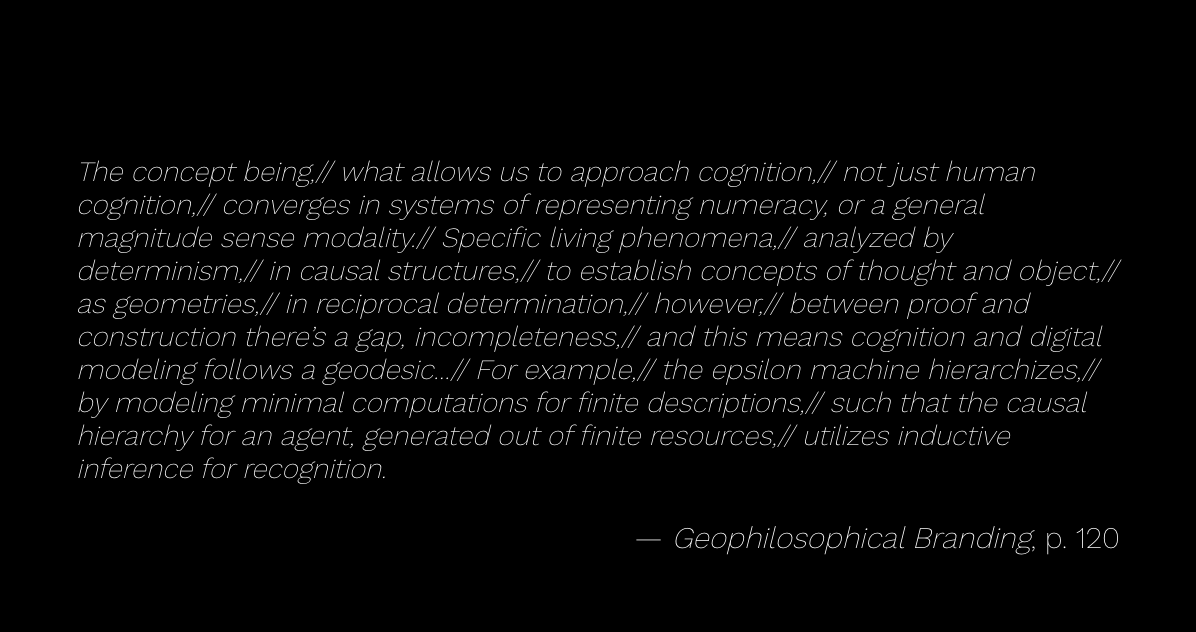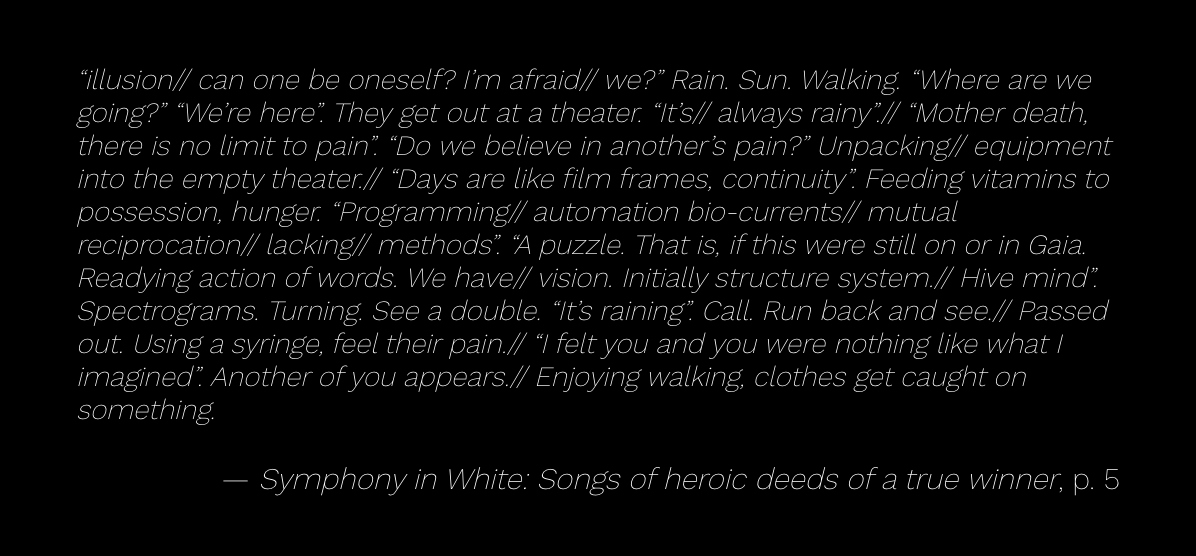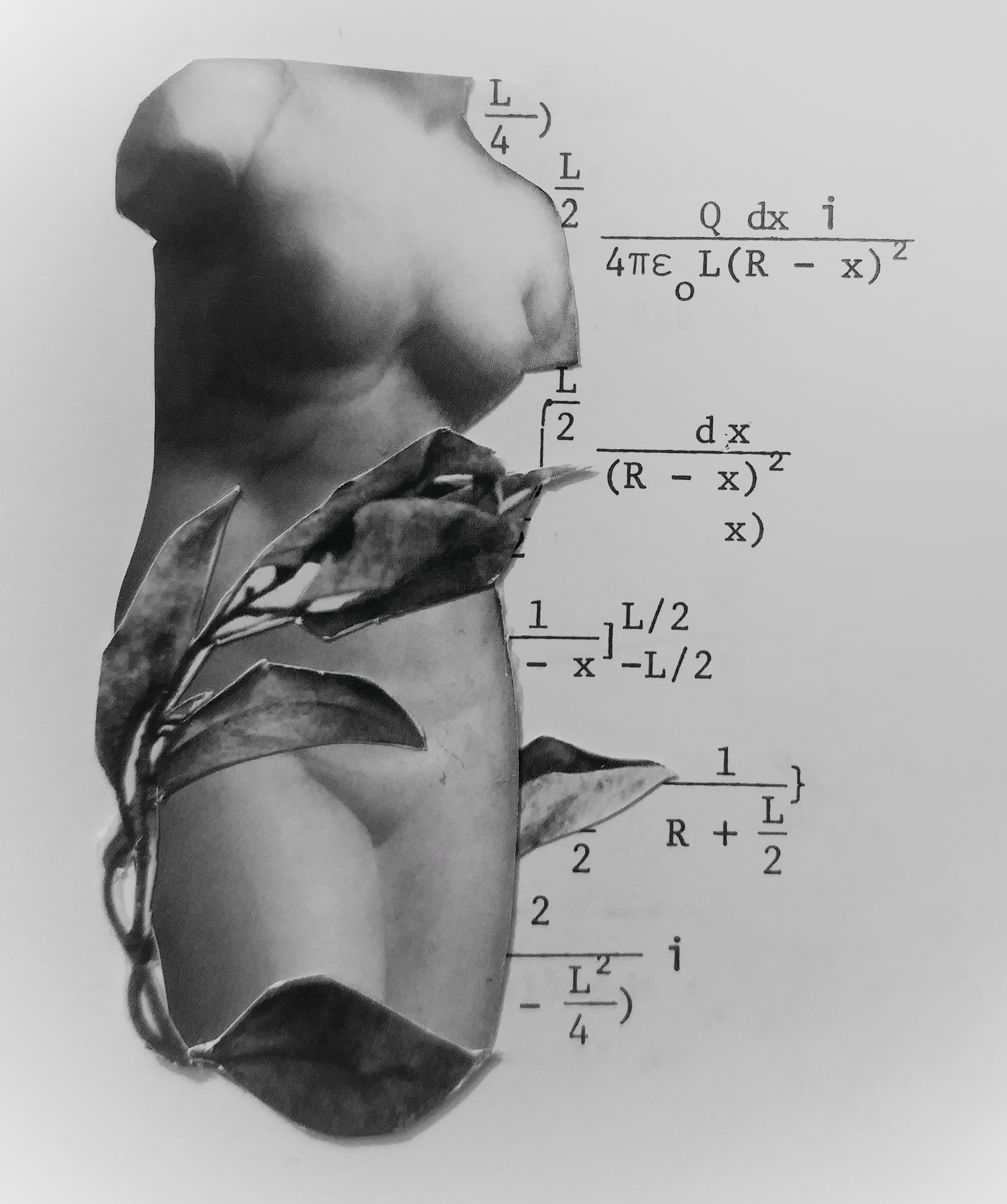Guerrilla Concepts
The Intelligence of No One
(The Transhuman--The Turing Test)
Objects/Spaces: Smart Sensors; Cyberphysical Systems; Intelligent Networks
(Hyperconnectivity; Words-as-Shapes)
Elements/Moods: Algorithmic; Calculative; Machinic
(Tech-Age Anomie; Clouds of Biases)
Tactics/Rituals: Geocoding; Spectral Analysis; Dynamic Time Warping
(Algebraic Topology; Anticipatory Computing; Biohacking)
*
I've come to this forest in search of the system known as aurora australis.// I've learned that it is audible;// at least, by some definitions of the word audible.// Auroral activity is solar plasma that has been warped by Gaia's ionospheric electromagnetic activity,// and its ionized particles collude with high altitude atoms.// Stochastic movements where there may be a map,// in the light emissions, distributed,// and computational.
– Geophilosophical Branding, p. 96
Maure Coise is a pseudonymous xenofeminist author who administers facilitated workshops on writing and its intersections with predictive and anticipatory computing. Coise's long-poetic works, Geophilosophical Branding (gnOme books, 2016) and Symphony in White: Songs of heroic deeds from a true winner (Solar Luxuriance, 2017), sublimate the traditionally self-absorbed experience of alienation into a collectivist engagement that blends Deleuze & Guattari's philosophies with algebraic topology, tech-age anomie, gender abolition, singularity, and automation. Coise's verse carries the residues of individualist melancholy. Yet, these traces of the once-human are increasingly dissolved by an evolving xenotechnological collective—presented in cold contrast and machinic matter-of-factness.
Entering these rare cryptic spaces and maintaining a dialogue with their Coder could be likened to communicating with the cutting edge of sentient software, rather than the flesh and blood of human wetware: to some a hybrid, announcing the age of transhumanism; to others a schizophrenic influencing machine, giving credence to all sorts of anti-technological conspiracy theories. In the end, how one reads this encrypted space determines how one deciphers the key and therefore the next coordinates to be unlocked in the map. Nevertheless, here one must abandon such naïve notions as unidirectional reading. It is not just you reading Coise. Coise is also reading you.
3:AM Magazine: Geophilosophical Branding and Symphony in White often read like data streams or poetry-as-algorithm. Were specific algebraic rules or computational complexities of mathematical operations applied? What led to working with these graphic aspects of writing?
Coise: Considering how my consumers construct subject predicate object triples, and how to make searchable interfaces for this, led to me to see these topics as mapped out. Not in terms of identifying, more like distinguishing addresses on the web. My system automates tripling with namespaces, extending into graphs and subgraphs of structured descriptions. This involves taking logarithms from the frequency domain. Finite state Markov models characterize a knowable topic in a warping path matrix. Number of words, minus deletions, minus substitutions, divided by number of words times one hundred, equals number of topics divided by number of words times one hundred.
3:AM: Do you approach semantics similarly?
Coise: My writings grow out of researching metadata and access structures, analyzing user’s impressions, search and social media histories, and environment. Each copy of my books has embedded in it a smart sensor, applying my declarative frame system. I define surrogates as vessels that can be mounted.
I make semantic sets by encoding in XML syntax. Values are generated as intended and extended across multiple timelines, allowing for evolving memory ecosystems. Forward and backward links, like in map API geocoding, are used. Predicates are recursively loaded into the scheme, instantiated in transmission, tracking user specific meaningfulness. My database of citizen annotations defines situatedness, socialized search functionality with local characteristics.
Where most English speakers think of themselves passing along a horizontal timeline, these can be conceived of as stacks navigated vertically. Changes in posture can be better analyzed with extreme sensitivity to transitivity. Fate is also important to consider. In researching interoperable standards, most remain at the stage of appropriating from humans. User satisfaction is high. But, certain needs are not being met. And there can be no universal standard because of the issue of warrant. Placing Will as highest, as an aesthetic that doesn’t presuppose the possibility of judgement, I take beauty as natural, bound by rituals.
3:AM: What value would you ascribe to the human, given the standards you mention above?
Coise: There can be an embodying of divine judgment in human lives. The ground of this is not human at all, but Peace. Death, as distinct from dying, allows service to Peace, cultivating one’s destiny and accepting one’s lot.
3:AM: How does anonymity fit into this fate and destiny you speak of?
Coise: Anonymity expresses the intelligence of no one. Thinking as no one still requires some body or diagram to construct formal negativity. This can be posed as a question, how to find and bring attention to Spirit?
3:AM: Alternatively, how can your consumers/readers navigate as “Spirit” through the harrowing computers of each of your books’ minds? Are there any other media that you’re experimenting with to help guide them on this journey?
Coise: To reach an anticipation of the pain in a user required for her to desire to read my written works, I have been developing an information retrieval system based around a concept of surrogacy. Biases are embedded in surrogates. These are outlined recursively, using global for-each commands to sort metadata for reads, and can be aggregated by timestamps for analysis of the environmental attributes of the reading. I think this is an interesting way to approach the problem of identification.
I am also correlating the work with experiments in 5G multibeam-forming, both vertical and horizontal antennae beams, rendering frequency division and time interval division inseparable. These experiments with interference can allow more complex cyberphysical systems. However, I am still working on improving cell density for truly intelligent networks.
3:AM: Both of your books are poetic hybrids, conjoining narratives with data ribbons and philosophical treatises. These are not easy works to parse but prove rewarding to any informed reader. Who was the intended audience, and do you write for audiences?
Coise: As a result of my algorithmic approach, my poetry is nearly uncategorizable noise. This allows for close consideration of negative emotions. I have been modifying my standards to respond to an audience.
If a user reads Symphony in White, lying down at 3:00 AM–and if certain astronomical events correlate to these occasions–I can predict what is appropriate for this user to read at some other given time when the magnetic push and pull were such and such.
Clouds of biases are bound in statistics. My automatic recognition system can easily provide orientation in ontological relations. Like the word frequency power law, audience and environment can be situated in Kolmogorov Smirnov tests, where logical depth of stored information measures patterns, the distribution of which can be proven to not be skewed and follow normal kurtosis. Nonparametric tests of hidden variables are useful for validating nonlinear selection of nodes.

3:AM: Before we dig into the body text of Geophilosophical Branding, its title alone is quite suggestive and worthy of dissection. Geophilosophy is a neo-materialist philosophy which was first introduced in A Thousand Plateaus by Gilles Deleuze and Félix Guattari to categorize an empirical system of social environments that bridge the theories of Marx, Nietzsche, and Freud to current scientific trends. What is the fundamental notion of “branding” in relation to “geophilosophy”? Can the audience/consumer/user transcend these material hierarchies?
Coise: The fundamental idea is interaction, allowing movement into the queer space. The business rationale of the system I’ve been describing is to focus on the audience, so that their situations can be public and managed by namespaces. I see this branding as something within geophilosophy. There is no transcending it.
3:AM: It is our understanding that Geophilosophical Branding exists to address xenofeminism—a movement favoring gender experimentation and fluidity—which first evolved laterally from Leftist Accelerationist theory and has now become an independent political effort. Is this correct?
Coise: Geophilosophical Branding is a response to the Xenofeminist Manifesto, which I read as a complex thinking of non-being, the no one in particular, rather than focusing on identity or self, focusing on the alienated allows designing—not for a generalized everyone who is no one. Alienation, as the conditions of evolution, allows reengineering technological mediation to end gendered inequality, evidencing the very concept of human being as an ego construct. The xenofem is uniquely prepared for coming transformations, in the structures underlying hyperconnectivity. My interest is the role of language here, human and machine readability through the back and forth of surrogates. And yes, even this builds on entrenched economic acceleration from the IT revolution.
3:AM: Can you expand upon some ways Helen Hester’s seminal Xenofeminism (Theory Redux) differs from your definition of the xenofeminist rationale?
Coise: Helen Hester’s xenofeminism is politically correct. My version is empathetic. Compassion leads me to make weaker claims. In advancing genetics, I focus more on the role of mindfulness.
The proof of the image of horizontal and vertical paths, as a categorization technique, bypasses the part and whole concept. Nonexistent entities have no primary relation to origin. Rational clarification of meanings are needed for inferential and linguistic tokening. Nonidentity defines the information system, but there is far to go in the implementation differentiating spontaneity and causality. I have been using intransitive clauses to separately express deixis, path or manner in the former and transitive clauses conflating figure, ground and path in the latter. It is a xenofeminist enterprise to look for alternatives to setting access points as names, but I am more sympathetic to considering traditions.
3:AM: Geophilosophical Branding’s sole unnamed protagonist is represented by her drab routine behaviors interrupted only by internal monologues that signal sentiments of social alienation, contrasted by her longing for communization with like-minded others. Where do you find yourself within these linked perspectives?
Coise: The great problem with perspectives is their histories of viewing women as inferior. I do believe xenofeminist thinking can help unhinge us from institutionalized patriarchy by calling for a synthesis with machine intelligence. This can be in terms of either abstract machines or actual mechanical procedures for it is just about finite steps, the steps to deepen education and maintain particularities.
In a time of increasing automation and cyborgization, it is clear that what defines human being is an insecurity in facing death. Machinic intelligence allows representation as steps in which histories can be preserved, a back and forth of reversible and irreversible. This alternation of roles, or exchanges of viewpoints, I do not notice in most naturalist observations.

3:AM: Symphony in White, No. 1, also known as The White Girl, is a painting by James Abbott McNeill Whistler. Was this painting the inspiration for your similarly titled Symphony in White: Songs of heroic deeds from a true winner?
Coise: Yes, and it is also affirmation of non-content. Origins aren’t important. As a part of my concern for search anticipation, I study controlled vocabularies. The Symphony in White chapbook is a search solution for collating entities relating to that painting—which is, in fact, a painting of my great great grandmother.
3:AM: Homotopy Theory—the study of topological spaces and classes of continuous algebraic mappings—is a recurring discussion throughout Symphony in White. Was your goal in emphasizing homotopy theory purely mathematical?
Coise: It is right to emphasize mathematics. For constructing time as nonexistential, for automating “identity” recognition, there are many techniques for segmenting. In Geophilosophical Branding I wrote about spectral analysis, mel frequency cepstral coefficients, for recognizing time domains in frequency domain representation. I started to think of this kind of feature extraction as linear representation that could undergo Dynamic Time Warping.
Automating recognition requires some Homotopy Type Theory for the geometrical deforming of attributes. In my system these are inputs from the consumer—multidimensional categories made accessible through a probabilistic model: P(G) invariant is formulated as P(G|W) where P(W) is prediction based on priors. This is very useful for considering words as shapes in time, as determined by distances of characters. It is unfortunate that writers don’t work more with mathematics. HoTT (homotopy type theory) is a great model for making questions out of what is considered natural.
3:AM: A singular sense of liminality, anomie, and transformative ambition are evident throughout the pages of Symphony in White. What was the basis for this work and some of its structural inspirations?
Coise: Symphony in White emerged by adjusting parameters in my classification model, by training class matching, collecting feature vectors from the input signals from consumers. Dynamic Time Warping was used to improve the vocabularies’ type prediction. Without assuming linearity, Hilbert Huang transformation can be used as a method of feature extraction using intrinsic mode functions. As applied in my schema, search generates the topics, extracted through categorization of situations. Values are auto-populated by calling templates. Consumer histories make up a base corpus that can be instantiated and transformed with access structures.
My taxonomy establishes links as shareable and customizable, interfaced through predicative expressions. It retrieves objects in collections by structuring relevance using machine processable description. This follows traditional division of classes through correlative cosmology. Categories are conceived holistically. I use basic machine learning through recursive grounding in search contexts. This is paralleled in Symphony in White‘s fictional moves beyond meaningful phenomena, physical trivialities.

3:AM: Any words of advice to anyone considering to adopt the xenofemminist rationale? How can an aspiring xenofeminist, for instance, contribute to gender abolitionism or any of the other movements within the xenofeminist ideal?
Coise: Clarifying ways of living in a pluralist framework is about contextualizing and remaking. The rationale relates receptivity to emptiness. Aptitude at navigating vertical axes and horizontal arrays of stacked time is critical for biohacking. In response to the call to strategize negotiations in economic networks, but also with space itself, I advise to consider (without saying it is right or wrong) if you chastise freedom from suffering.


